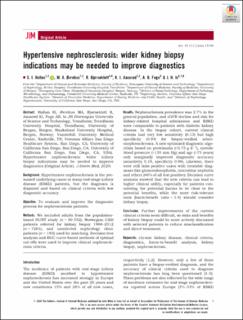| dc.contributor.author | Hallan, Stein | |
| dc.contributor.author | Øvrehus, Marius Altern | |
| dc.contributor.author | Bjørneklett, Rune | |
| dc.contributor.author | Aasarød, Knut Ivar | |
| dc.contributor.author | Fogo, Agnes B. | |
| dc.contributor.author | Ix, Joachim H. | |
| dc.date.accessioned | 2020-08-19T11:05:31Z | |
| dc.date.available | 2020-08-19T11:05:31Z | |
| dc.date.created | 2020-08-10T14:13:08Z | |
| dc.date.issued | 2020 | |
| dc.identifier.citation | Journal of Internal Medicine. 2020, 1-15. | en_US |
| dc.identifier.issn | 0954-6820 | |
| dc.identifier.uri | https://hdl.handle.net/11250/2672983 | |
| dc.description.abstract | Background. Hypertensive nephrosclerosis is the presumed underlying cause in many end-stage kidney
disease (ESKD) patients, but the diagnosis is
disputed and based on clinical criteria with low
diagnostic accuracy.
Objective. To evaluate and improve the diagnostic
process for nephrosclerosis patients.
Methods. We included adults from the populationbased HUNT study (n = 50 552), Norwegian CKD
patients referred for kidney biopsy 1988–2012
(n = 7261), and unselected nephrology clinic
patients (n = 193) used for matching. Decision tree
analysis and ROC curve-based methods of optimal
cut-offs were used to improve clinical nephrosclerosis criteria.
Results. Nephrosclerosis prevalence was 2.7% in the
general population, and eGFR decline and risk for
kidney-related hospital admissions and ESKD
were comparable to patients with diabetic kidney
disease. In the biopsy cohort, current clinical
criteria had very low sensitivity (0.13) but high
specificity (0.94) for biopsy-verified arterionephrosclerosis. A new optimized diagnostic algorithm based on proteinuria (<0.75 g d 1
), systolic
blood pressure (>155 mm Hg) and age (>75 years)
only marginally improved diagnostic accuracy
(sensitivity 0.19, specificity 0.96). Likewise, there
were still false-positive cases with treatable diagnoses like glomerulonephritis, interstitial nephritis
and others (40% of all test positive). Decision curve
analysis showed that the new criteria can lead to
higher clinical utility, especially for patients considering the potential harms to be close to the
potential benefits, while the more risk-tolerant
ones (harm:benefit ratio < 1:4) should consider
kidney biopsy.
Conclusion. Further improvements of the current
clinical criteria seem difficult, so risks and benefits
of kidney biopsy could be more actively discussed
with selected patients to reduce misclassification
and direct treatment. | en_US |
| dc.language.iso | eng | en_US |
| dc.publisher | Wiley Online Library | en_US |
| dc.title | Hypertensive nephrosclerosis: wider kidney biopsy indications may be needed to improve diagnostics | en_US |
| dc.type | Peer reviewed | en_US |
| dc.type | Journal article | en_US |
| dc.description.version | publishedVersion | en_US |
| dc.source.pagenumber | 1-15 | en_US |
| dc.source.journal | Journal of Internal Medicine | en_US |
| dc.identifier.doi | 10.1111/joim.13146 | |
| dc.identifier.cristin | 1822528 | |
| dc.description.localcode | © 2020 The Authors. Journal of Internal Medicine published by John Wiley & Sons Ltd on behalf of Association for Publication of The Journal of Internal Medicine. This is an open access article under the terms of the Creative Commons Attribution-Non Commercial-NoDerivs License, which permits use and distribution in any medium, provided the original work is properly cited, the use is non-commercial and no modifications or adaptations are made. | en_US |
| cristin.ispublished | true | |
| cristin.fulltext | original | |
| cristin.qualitycode | 2 | |
